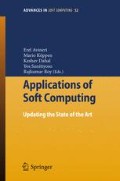Abstract
This study investigates the potential of Relevance Vector Machine (RVM)-based approach to predict the ultimate capacity of laterally loaded pile in clay. RVM is a sparse approximate Bayesian kernel method. It can be seen as a probabilistic version of support vector machine. It provides much sparser regressors without compromising performance, and kernel bases give a small but worthwhile improvement in performance. RVM model outperforms the two other models based on root-mean-square-error (RMSE) and mean-absolute-error (MAE) performance criteria. It also estimates the prediction variance. The results presented in this paper clearly highlight that the RVM is a robust tool for prediction of ultimate capacity of laterally loaded piles in clay.
Access this chapter
Tax calculation will be finalised at checkout
Purchases are for personal use only
Preview
Unable to display preview. Download preview PDF.
References
Czerniak, E.: Resistance to overturning of single, short piles. J. Structural Engg. 83(ST2), 1–25 (1957)
Hansen, B.J.: The ultimate resistance of rigid piles against transversal forces. Geo-tekenish institute Bull. No.12, Copenhagen (1961)
Broms, B.B.: Lateral resistance of pile in cohesive soils. J. Soil Mech. Found. Div. 90(SM2), 27–63 (1964)
Meyerhof, G.G.: The bearing capacity of rigid piles and pile groups under inclined loads in clay. Canadian Geotechnical Journal 18, 297–300 (1981)
Chow, Y.K., Chan, L.F., Liu, L.F., Lee, S.L.: Prediction of pile capacity from sress-wave measurements: A neural network approach. International Journal of Numerical and Analytical Methods in Geomechanics 19, 107–126 (1995)
Lee, I.M., Lee, J.H.: Prediction of pile bearing capacity using artificial neural network. Computers and Geotechnics 18(3), 189–200 (1996)
Abu Kiefa, M.A.: General Regression Neural Networks for driven piles in cohe-sionless soils. Journal of Geotechnical and Geoenviromental Engineering 124(12), 1177–1185 (1998)
Nawari, N.O., Liang, R., Nusairat, J.: Artificial Intelligence Techniques for the Design and Analysis of Deep Foundations. Electronics Journal of Geotechnical Engineering (1999)
Park, D., Rilett, L.R.: Forecasting freeway link ravel times with a multi-layer feed for-ward neural network. Computer Aided Civil And infa Structure Engineering 14, 358–367 (1999)
Kecman, V.: Leaning And Soft Computing: Support Vector Machines. In: Neural Net-works, And Fuzzy Logic Models. MIT press, Cambridge (2001)
Rao, K.M., Suresh Kumar, V.: Measured and predicted response of laterally loaded piles. In: Proc. 6th International Conference and Exhibition on Piling and Deep Foundations, Bombay, pp. 1.6.1–1.6.7. Deep Foundation Institute (1996)
Tipping, M.E.: Sparse Bayesian learning and the relevance vector machine. J. Mach. Learn. 1, 211–244 (2001)
Tipping, M.E.: The relevance vector machine. Adv. Neural Inf. Process. Syst. 12, 625–658 (2000)
Berger, J.O.: Statistical Decision Theory and Bayesian Analysis, 2nd edn. Springer, New York (1985)
Wahaba, G.: A comparison of GCV and GML for choosing the smoothing parameters in the generalized spline-smoothing problem. Ann. Stat. 4, 1378–1402 (1985)
MacKay, D.J.: Bayesian methods for adaptive models. Ph.D. thesis, Dep. of Comput. and Neural Sysyt., Calif Inst. of Technol., Pasadena. Calif. (1992)
Sincero, A.P.: Predicting Mixing Power Using Artificial Neural Network. EWRI World Water and Environmental (2003)
MathWork Inc, Matlab user’s manual, Version 5.3. Natick, MA, The MathWorks, Inc. (1999)
Li, Y., Campbell, C., Tipping, M.: Bayesian automatic relevance determination algorithms for classifying gene expression data. Bioinformatics 18(10), 1332–1339 (2002)
Author information
Authors and Affiliations
Editor information
Editors and Affiliations
Rights and permissions
Copyright information
© 2009 Springer-Verlag Berlin Heidelberg
About this paper
Cite this paper
Samui, P., Bhattacharya, G., Choudhury, D. (2009). Prediction of Ultimate Capacity of Laterally Loaded Piles in Clay: A Relevance Vector Machine Approach. In: Avineri, E., Köppen, M., Dahal, K., Sunitiyoso, Y., Roy, R. (eds) Applications of Soft Computing. Advances in Soft Computing, vol 52. Springer, Berlin, Heidelberg. https://doi.org/10.1007/978-3-540-88079-0_13
Download citation
DOI: https://doi.org/10.1007/978-3-540-88079-0_13
Publisher Name: Springer, Berlin, Heidelberg
Print ISBN: 978-3-540-88078-3
Online ISBN: 978-3-540-88079-0
eBook Packages: EngineeringEngineering (R0)

